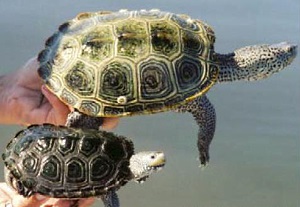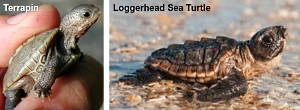How to Identify a Diamondback Terrapin

South Carolina is home to 142 species in the reptile/amphibian guild, 80% of which are found in the coastal plain region of our state due to the habitat and soil types found here. Because the diversity of these "herpetofauna" is greater in the coastal plain than any other region in South Carolina, the probability of misidentification by untrained eyes is also greatest near the coast.
As noted by an identification guide produced by the ACE Basin NERR, diamondback terrapins are unique in their appearance, which makes them readily identifiable. Maximum shell size of diamondback terrapins is <12 in. and males are much smaller (and with narrower heads) than their female counterparts. Diamondback terrapin colors and patterns are quite variable, so the best identification traits are the long, snake-like neck and 'toe-nails'.

Due to similar size and time of year when most likely to be seen by the public, diamondback terrapins in their first year of life are often confused for sea turtle hatchlings. Key differences between the two taxa include a smooth shell appearance for terrapins in contrast to a bumpy shell appearance for sea turtles. Also, diamondback terrapins are able to retract their front and rear limbs (that have 'toe nails') into their shell, whereas sea turtle flippers cannot be retracted into their shell. Lastly, sighting location is a good clue; sea turtles should only be hatching on the ocean side of beaches or, if in the estuary, in very close proximity to ocean inlets. In contrast, diamondback terrapin hatchlings are most likely to emerge from a very cryptic nest in your Azalea bush or swim in your pool, and if you see diamondback terrapin hatchlings, please remember to tell us about it.


